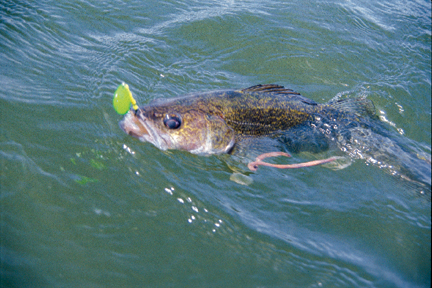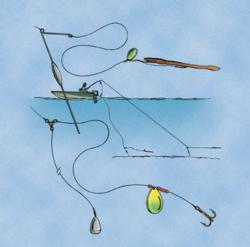Blade runner
Several walleye pros use spinner blades as their go-to technique

Take a good look in any top walleye pro’s tackle box and you’re likely to find spinners – lots of them. There’s an even better chance that you’ll discover a whole box dedicated for the sole purpose of storing and organizing spinner rigs by blade size, color and even shape. Once thought of as an outdated method that had seen better days, trolling spinners has seen a resurgence, and for good reason.
The reason is rather simple – they work. From our nation’s small natural lakes to the Great Lakes and from rivers to reservoirs, spinners have been racking up some tremendous catches and account for more than their share of walleye gold. This basic method has become the go-to technique for many of the country’s top pros, as it lends itself to a variety of situations.
Improvements and refinements in the basic spinner rig have helped to spur the elevated interest in this time-honored technique. The short, extra-heavy leader of old has been replaced by something lighter, longer and more refined. The standard gold or copper blades have been complemented by all kinds of hot new finishes, including some beautifully painted color combinations. There are even little plastic clevises that allow for quick blade changes, which can save you valuable time. The ability to change blades quickly will have you changing colors, shapes and sizes more often, hopefully resulting in the discovery of the optimum combination for that given moment.
Ask a walleye pro if color is important and you’ll likely get a resounding “Yes!” In fact, some of the type-A personalities will insist that bead color can also make a difference, but is that taking things a bit too far? Well, maybe – that is, unless your next paycheck depends on it. In that case, you might swear that an orange and chartreuse No. 4 Colorado with a gold back positioned in front of a red, then green, then red, and then green again bead combination is absolutely the only way to go. Some anglers will swear by nothing but red beads and will use them with every other blade-color combination imaginable. The thing to keep in mind is that color can make a difference, and it wouldn’t hurt to change things up once in a while, especially if you’re unhappy with the current results.
Size and shape are other considerations when putting together an effective spinner campaign and include the tiniest of blades no larger than a small fingernail to giant, hard-pounding No. 6s and No. 7s. The size you select will depend on the existing conditions and the size of your intended victims. Small blades can be effective on walleyes throughout their size range while the larger blades might be more acceptable to the bigger models – let’s say those walleyes over 5 pounds. If your intent is simply to catch fish, it might be a good idea to err on the small side. However, if it’s a real hog you’re after, the big blades could well be the ticket to the fish of a lifetime.
Blade shapes are categorized by three basic designs and include the Colorado, Indiana and willow-leaf blades. Colorado blades produce the hardest thump and offer the ultimate in sound and vibration, but they demand slower trolling speeds. Indiana blades are more of a teardrop shape and produce a little less vibration than the Colorados but can be trolled at higher speeds of up to 2 mph or so. Willow-leafs, on the other hand, are slender in shape and produce the smallest amount of sound and vibration of the three, but they can be successfully trolled at speeds up to 3 mph or more.
 The most common rig includes a multiple hook harness and a big, fat night crawler, but spinners also work well with leeches, minnows and some plastic baits. Plastics are often overlooked but can be extremely effective, especially when the nondesirable types won’t leave you alone. Perch, white bass and panfish can make a real nuisance of themselves and will tear the real thing to pieces. Plastics can take a beating and keep on catching, which will keep your bait in the zone longer and up your odds for contacting the real deal. Plastic baits that resemble a natural crawler have been top producers at several tournaments.
The most common rig includes a multiple hook harness and a big, fat night crawler, but spinners also work well with leeches, minnows and some plastic baits. Plastics are often overlooked but can be extremely effective, especially when the nondesirable types won’t leave you alone. Perch, white bass and panfish can make a real nuisance of themselves and will tear the real thing to pieces. Plastics can take a beating and keep on catching, which will keep your bait in the zone longer and up your odds for contacting the real deal. Plastic baits that resemble a natural crawler have been top producers at several tournaments.
Unless you’re fishing extremely shallow, you’ll need to add some weight to your spinner to achieve any appreciable level of depth. There are several different ways to get it done, including the use of a bottom bouncer, three-way rig, in-line weight or snap weight.
A bouncer-and-spinner combo is an excellent pick for getting familiar with an unfamiliar lake. For example, let’s say you’ve located some offshore humps on a map and you want to check them out. You really can’t do a satisfactory job on plane and will probably have to slow down to get it done. Instead, you’d be more thorough and effective if you were to cruise back and forth and up and down the breaklines slowly, looking for deeper rock and gravel as well as inside turns and points. While you’re checking things out, you might as well be fishing, and a bouncer setup will let you accomplish both.
Bouncers and spinners were made for fishing structure and are relatively “goof-proof” and actually easy to use. You can drop a bait to the bottom and slowly cruise along while watching the depth finder. If you get a hit, simply rear back and set the hook. If you’re missing fish, wait just a moment before the set and give them a little more time to fully engulf the bait. By waiting on the set, you can sometimes tease walleyes into taking the bait.
Another extremely productive method for dealing with short-striking walleyes is a very deliberate drop or stall of the bait. You might be surprised by how many fish you can turn after they’ve hit and missed your bait by pointing the rod toward the bouncer and reaching as far as you can. This action will stall the spinner out, and the effect probably looks like a bait that has been injured by the first strike and is falling to the bottom. The fall is when walleyes will often pick up the bait. The key is being on your toes with the stall, as it has to be done immediately after the strike to be effective. Longer rods can help with the slack factor, and lengths up to 7 feet or more are recommended.
Transition areas, flats and muddy bottoms call for a different spinner setup, and this is where a three-way swivel and a bell-sinker rig really come into play. The bell sinker is tied to a dropper line that can be adjusted to vary the depth your bait is running. If you’re watching your depth finder and see fish holding tight to the bottom, keep the dropper short, and if they’re off the bottom, lengthen it out. You can also get away with a longer snell on a three-way rig by varying the length of the dropper. Spinner blades, beads and clevises are heavy and actually sink. Although the resistance a blade creates when pulled does add some lift, it will still lose depth, and a snell that is too long could have your bait dragging on the bottom. It’s something you’ll want to consider when adjusting your rig.
So how much drop are you actually getting? To find out, try running it in shallow water alongside the boat, where you can actually see the bait. If that isn’t possible, you’ll know if you’re constantly hanging up or if your hooks are becoming fouled with debris.
When fish suspend way up and off the bottom, spinners still have that certain something that walleyes can’t seem to resist. Getting the bait in front of suspended noses takes a completely different approach. Instead of measuring from the bottom up, you’ll have to calculate from the surface down, and instead of bouncers or three-ways (although they can still work), you might want to try an in-line weight or a snap weight. If you’re using an in-line weight, you’ll want to keep the snell between 6 and maybe 8 feet. The length keeps the bait away from the sinker for the finesse but still allows you to get a net under the fish when you do get it to the boat. Another thing you might try is painting the in-line sinker to match the available forage, like green for perch and silver for shiners.
To get the bait to run at the right depth, you’ll have to experiment a little with different-sized weights, or by adjusting the amount of line you have out after the sinker. It’s not an exact science, but with some experience you can become proficient enough to target a specific depth.
Snap weights can take the sinker totally out of the presentation. Simply tie on a swivel, hook up a spinner and let out as much line as you want before hooking on a snap weight. A snap weight is nothing more than a weight connected to a removable clip that holds on directly to the line. When you hook a fish, reel up to the snap, remove it and fight the fish in the rest of the way.
The only shortcoming spinners may have is their window of productivity. They really don’t come into their own until water temperatures pop into the upper 50-degree range or higher. That virtually eliminates the early spring and late fall periods of the open-water season. However, from late spring through early fall, they can be the very best method for finding and catching fish. It’s so easy to get in a rut, especially when fishing for old marble ‘eyes. The next time it happens, try turning the tables and take a few walleyes for a spin.